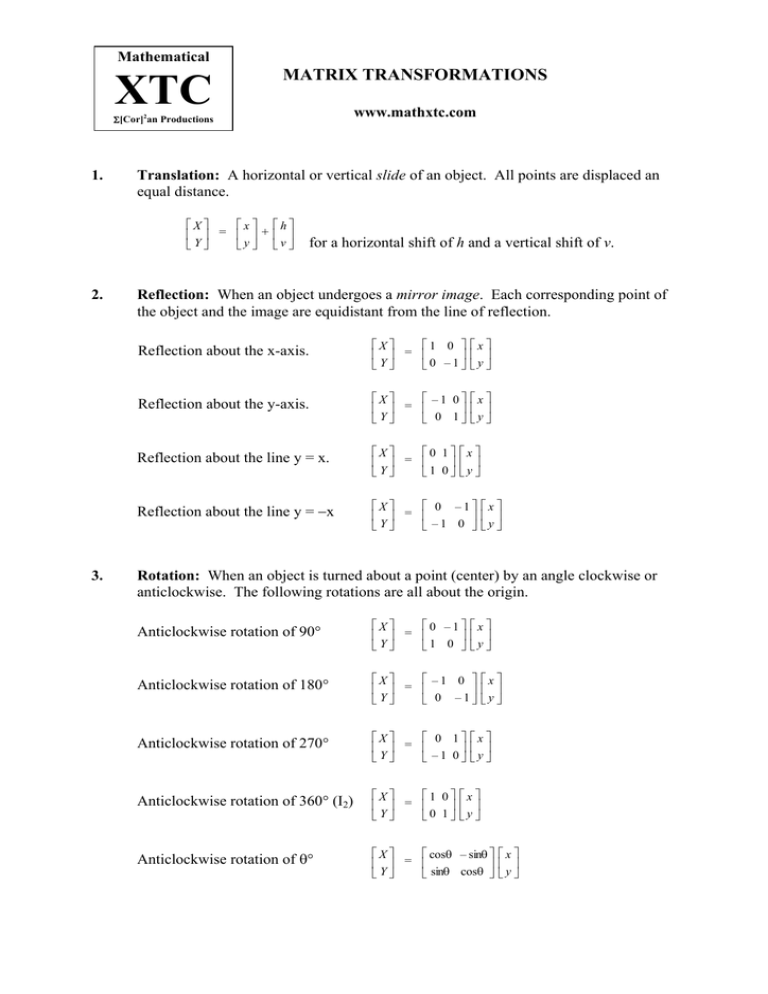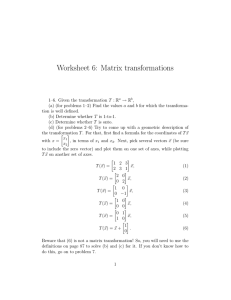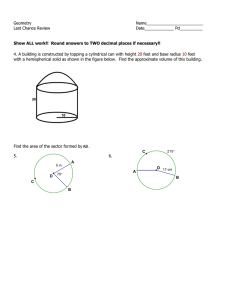matrix transformations
advertisement

Mathematical XTC MATRIX TRANSFORMATIONS www.mathxtc.com Σ[Cor]2an Productions 1. Translation: A horizontal or vertical slide of an object. All points are displaced an equal distance. ⎡X⎤ ⎡x ⎤ ⎡h⎤ ⎢ ⎥ = ⎢ ⎥+⎢ ⎥ ⎣Y⎦ ⎣y ⎦ ⎣v ⎦ 2. 3. for a horizontal shift of h and a vertical shift of v. Reflection: When an object undergoes a mirror image. Each corresponding point of the object and the image are equidistant from the line of reflection. Reflection about the x-axis. ⎡X⎤ ⎡1 0 ⎤ ⎡x ⎤ ⎢ ⎥ = ⎢ ⎥⎢ ⎥ ⎣Y⎦ ⎣0 –1⎦ ⎣y ⎦ Reflection about the y-axis. ⎡X⎤ ⎡ –1 0⎤ ⎡x ⎤ ⎢ ⎥ = ⎢ ⎥⎢ ⎥ ⎣Y⎦ ⎣ 0 1⎦ ⎣y ⎦ Reflection about the line y = x. ⎡X⎤ ⎡0 1⎤ ⎡x ⎤ ⎢ ⎥ = ⎢ ⎥⎢ ⎥ ⎣Y⎦ ⎣1 0⎦ ⎣y ⎦ Reflection about the line y = −x ⎡X⎤ ⎡ 0 –1⎤ ⎡x ⎤ ⎢ ⎥ = ⎢ ⎥⎢ ⎥ Y ⎣ ⎦ ⎣ –1 0 ⎦ ⎣y ⎦ Rotation: When an object is turned about a point (center) by an angle clockwise or anticlockwise. The following rotations are all about the origin. Anticlockwise rotation of 90° ⎡X⎤ ⎡0 –1⎤ ⎡x ⎤ ⎢ ⎥ = ⎢ ⎥⎢ ⎥ ⎣Y⎦ ⎣1 0 ⎦ ⎣y ⎦ Anticlockwise rotation of 180° ⎡X⎤ ⎡ –1 0 ⎤ ⎡x ⎤ ⎥⎢ ⎥ ⎢ ⎥ = ⎢ ⎣Y⎦ ⎣ 0 –1⎦ ⎣y ⎦ Anticlockwise rotation of 270° ⎡X⎤ ⎡ 0 1⎤ ⎡x ⎤ ⎢ ⎥ = ⎢ ⎥⎢ ⎥ Y ⎣ ⎦ ⎣ –1 0⎦ ⎣y ⎦ Anticlockwise rotation of 360° (I2) ⎡X⎤ ⎡1 0⎤ ⎡x ⎤ ⎢ ⎥ = ⎢ ⎥⎢ ⎥ ⎣Y⎦ ⎣0 1⎦ ⎣y ⎦ Anticlockwise rotation of θ° ⎡X⎤ ⎡ cosθ – sinθ ⎤ ⎡ x ⎤ ⎢ ⎥ = ⎢ ⎥⎢ ⎥ ⎣ Y⎦ ⎣ sinθ cosθ ⎦ ⎣ y ⎦ 4. Dilation: When an object is reduced or enlarged by a scale factor. A dilation of scale factor kh in the x axis and kv in the y axis. ⎡X⎤ ⎡ kh 0 ⎤ ⎡ x ⎤ ⎢ ⎥ = ⎢ ⎥⎢ ⎥ ⎣ Y⎦ ⎣ 0 kv ⎦ ⎣ y ⎦ 5. Shear: When an object has every point displaced the same amount in a given direction parallel to a given line. Generally parallel to the x and y axis. The fixed line is called the axis of sheer. Sheer parallel to the x axis ⎡X⎤ ⎡1 λ ⎤ ⎡x ⎤ ⎢ ⎥ = ⎢ ⎥⎢ ⎥ ⎣Y⎦ ⎣0 1⎦ ⎣y ⎦ Sheer parallel to the y axis ⎡X⎤ ⎡1 0⎤ ⎡x ⎤ ⎢ ⎥ = ⎢ ⎥⎢ ⎥ ⎣Y⎦ ⎣λ 1⎦ ⎣y ⎦ NOTE 1. Try to remember these however a quick way to find matrix transformations is to use the following trick: ⎡a ⎢ ⎢ We know that: ⎢⎣ c b ⎤⎥ ⎥ ⎥ d⎦ ⎡a ⎡1⎤ ⎡a⎤ ⎢ ⎥ = ⎢ ⎥ and ⎢⎢ ⎣0⎦ ⎣c⎦ ⎢ ⎣c b ⎤⎥ ⎥ ⎥ d⎦ ⎡0⎤ ⎡b⎤ ⎢ ⎥=⎢ ⎥ ⎣1⎦ ⎣d⎦ The image of (1 , 0) under the transformation determines the first column of the transformation matrix and the image of (0 , 1) determines the second column. For example, if you know that the transformation is a reflection about the x axis. (1 , 0) Æ (1 , 0) and (0 , 1) Æ (0 , -1) ⎡1 ⎢ ⎢ hence the transformation matrix is ⎢⎣ 0 0 ⎤⎥ ⎥ ⎥ –1 ⎦ 2. When a shape with area A is transformed by matrix T the area of the image will be: |det T | × A 3. If Matrix T transforms point A to its image A′ then T –1 (The inverse of T) will transform A′ back to A. T –1 must exist. 4. Points are always premultiplied by the transformation matrix. Order of multiplication is crucial. Be careful when applying this to multiple transformations and their inverses.

